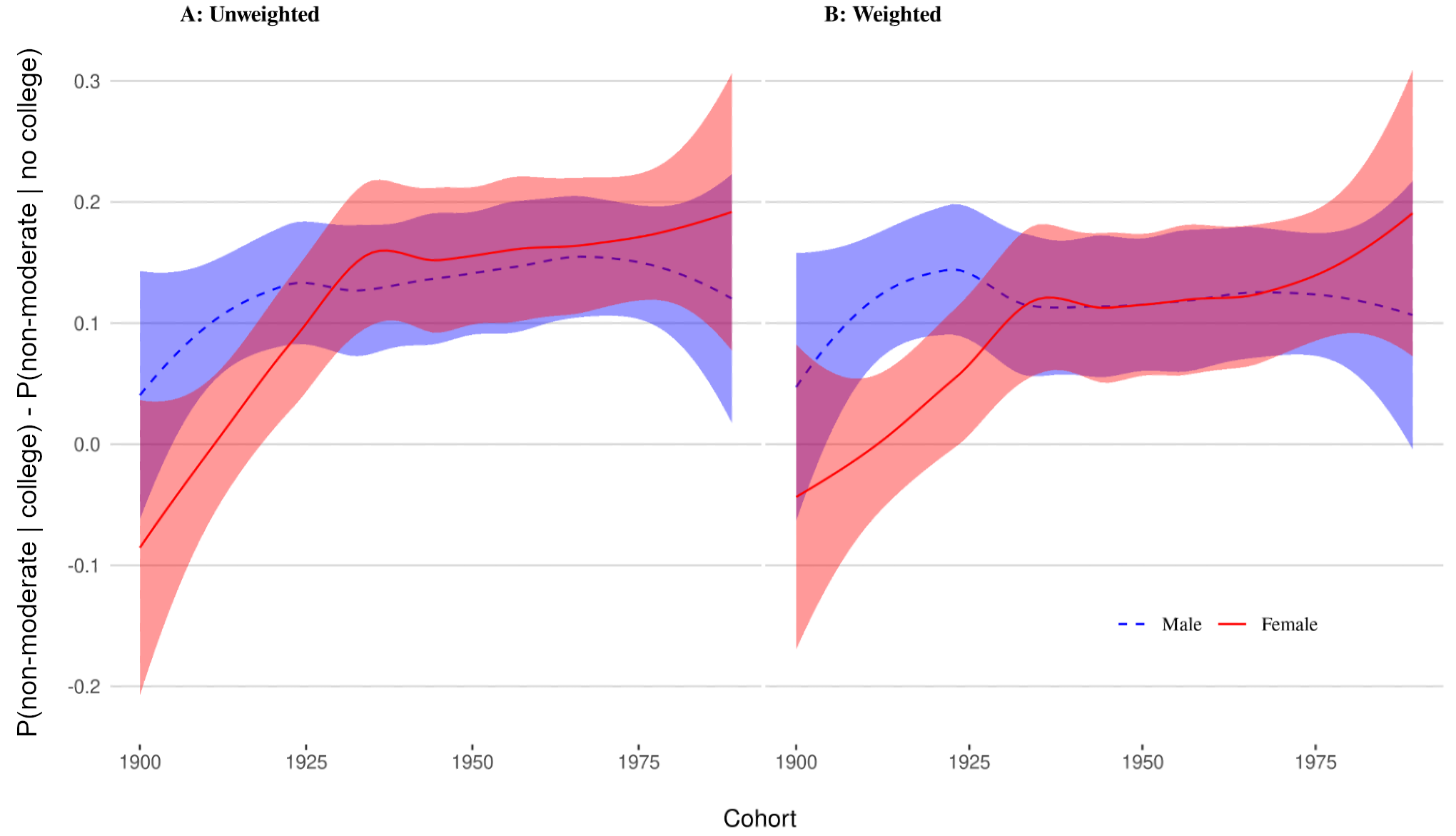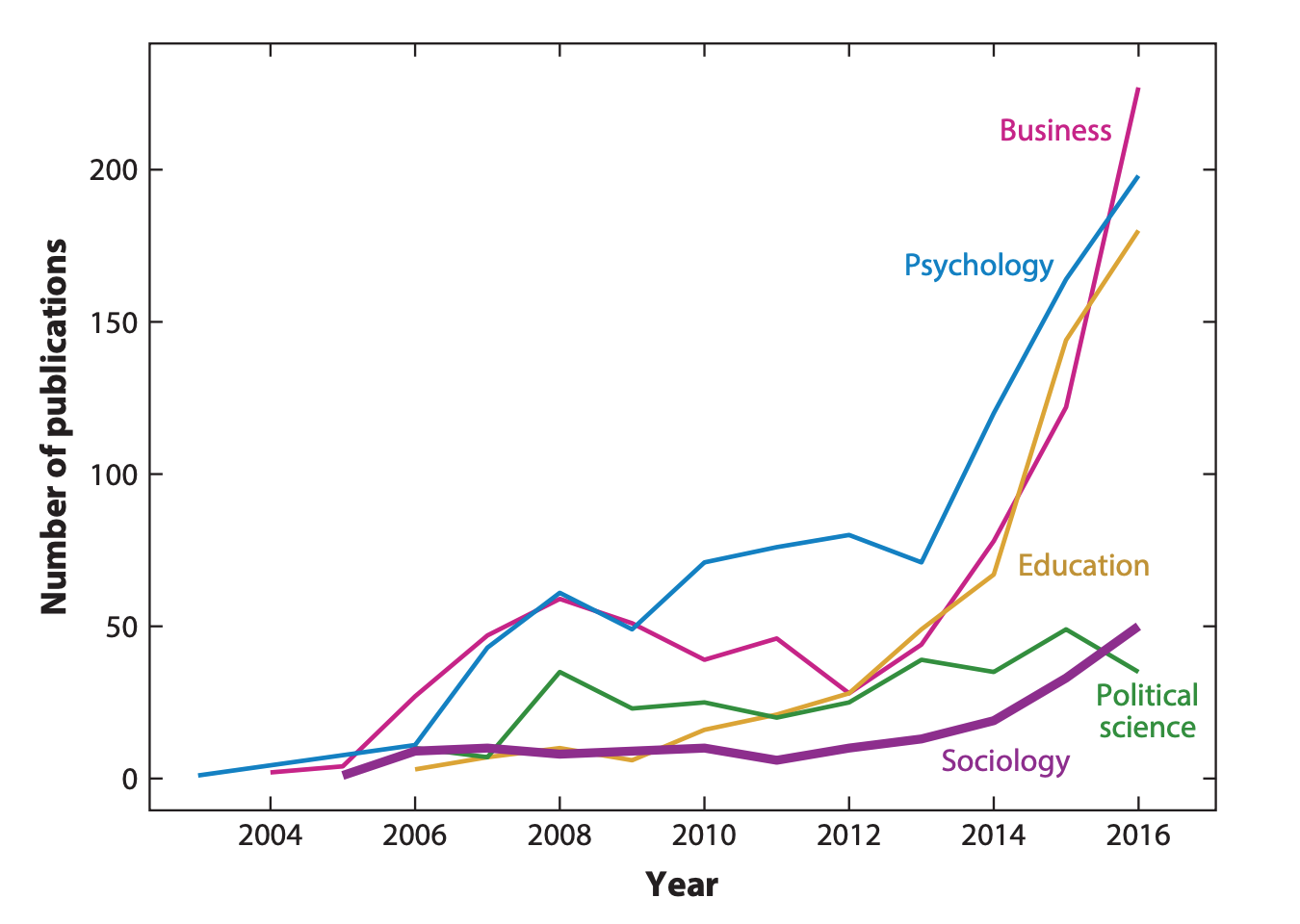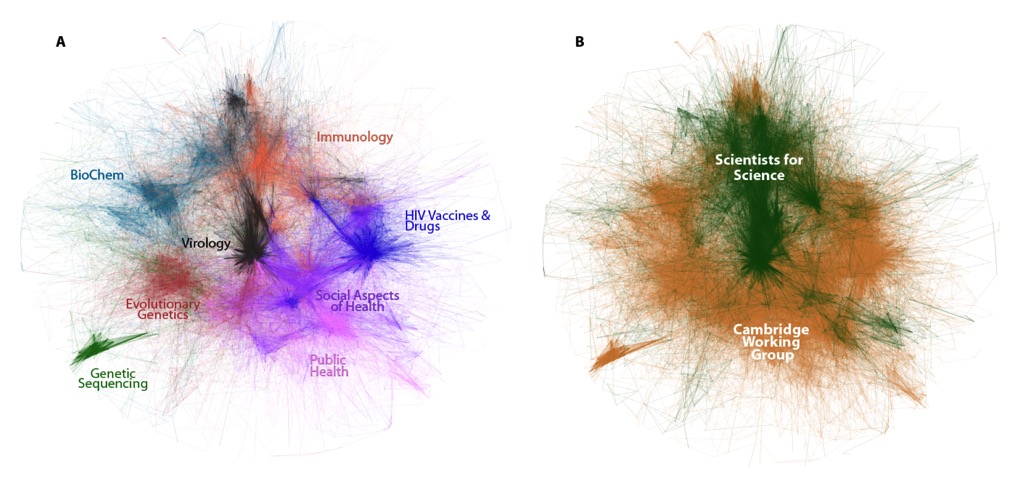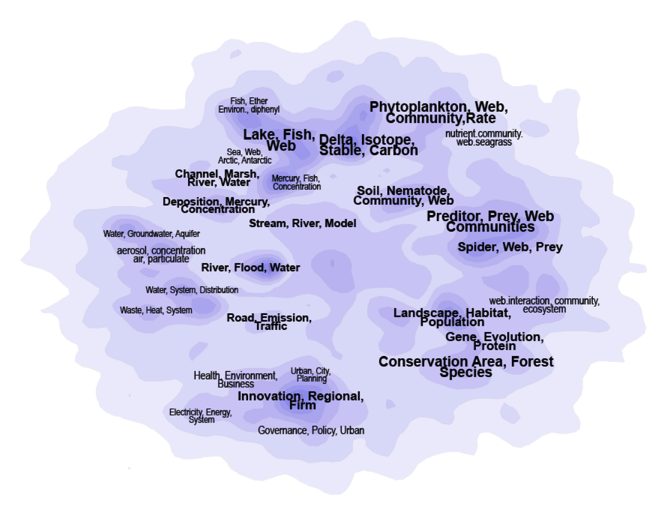"Gender Differential Effect of College on Political Orientation Over the Last 40 Years in the U.S.—a Propensity Score Weighting Approach" (with Stephen Vaisey, PLoS ONE, in press )

Figure: Difference in proportion of non-moderates between college goers and non-goers by gender.
"Computational Social Science and Sociology" (with Tom Wolff, Danielle Montagne, and Christopher A. Bail, Annual Review of Sociology 2020 )

Figure: Number of computational social science publications by year-2003-2016-across five scholarly disciplines.
"Boundary Violations and Adolescent Drinking: Observational Evidence That Symbolic Boundaries Moderate Social Influence" (PLoS ONE 2019 )
"Culturally Meaningful Networks: On the Transition from Military to Civilian Life in the United Kingdom" (Theory and Society 2018 )
"Formalizing Symbolic Boundaries" (Poetics 2018 )
Formal efforts to advance culture as an analytic concept can benefit from attending to the human disposition to categorize. I demonstrate this with regard to the concept of symbolic boundaries, which I conceptualize as dual classifications that describe what kind of behavior or opinion is appropriate for different kinds of people and put forward a corresponding (mathematical) formalization. Drawing on insights from cognitive science about categorization, I develop an understanding of “boundary breaching,” that is, what happens when these dual classifications are violated. This allows me to derive a model of network influence that accounts for how people evaluate behavior in others based on cultural classifications. I demonstrate how this model can be implemented empirically using data from the National Study of Youth and Religion. By drawing on our cognitive disposition to categorize, symbolic boundaries mediate structural effects of social influence.
$$Y = (GG′•A)Y•(–GSy) + AY + BX + U$$
Model of social influence accounting for the effect of symbolic boundary \(S\) with regard to behavior \(y\); equilibrium condition shown. For details, see the paper.
"Formal Studies of Culture: Issues, Challenges and Current Trends" (with John W. Mohr, Poetics 2018 )
Over the last two decades, the formal study of culture has grown into one of the most exciting, systematic, and dynamic sub-fields in sociology. In this introductory essay, we take stock of recent developments in this field. We highlight four emerging themes: (1) the maturation of the field that has occurred over the last two decades, (2) the rise and formalization of the “cultural matrix” approach to studying culture, (3) the development of various efforts to advance a more formal theory of culture, and (4) the proliferation of Big Data and the development of new kinds of quantitative and computational approaches to the study of culture, including the emergence of a new area focused on “computational hermeneutics.” We conclude by discussing future opportunities, challenges, and questions in formalizing culture.
"Disparate Foundations of Scientists’ Policy Positions On Contentious Biomedical Research" (with James Moody and Ryan Light, PNAS 2017 )
I ask what shapes scientists’ positions on policy debates which have the potential to re-define the future of society. I examine the formal public disagreement amongst high-status scientists, including Nobel laureates, concerning gain-of-function research—that is, research in which an entity such as a virus is manipulated to gain a new property such as transmissibility among species other than their natural hosts—that involves pathogens capable of triggering serious pandemics. Within this debate, two opposing factions emerge, both rooting their positions in competing claims to public-safety, providing a unique opportunity to understand what drives scientists’ policy positions when empirical resolutions are lacking. After scraping signatures from the petitions of both groups, I identify 19,257 academic papers belonging to these scientists. Then, using network analytical techniques, I identify their collaborative networks and position in the social structure of the debate. Employing generative probabilistic topic modeling, I derive the core themes that these scientists have worked on and approximate their location in the overall intellectual space of the debate. I find that participants’ policy positions are differentially predicted by their collaborators and their own research focus: peer behavior best predicts those supporting bans of gain-of-function research while research specialty best predicts those supporting restarting active research. The differential foundations for positions suggests that scientists’ policy positions are likely informed more by peers and interests than by empirical evidence.

Figure: Collaboration and position on gain-of-function research. (A) Scientists’ collaboration network. Nodes are petition signers, and edges are collaborations; layout via Fruchterman–Reingold, which tends to place scientists near collaborators; node size is proportionate to the total number of collaborators; n = 378. (B) Predicted probabilities of signing the SFS petition by number of collaborators who signed either the SFS (green) or CWG (orange) petition. Probabilities are based on logistic regression models (SI Appendix, Table S3); the shaded area represents the 95% CI for the “all controls” model, which adjusts for specialization, publication volume, and demographic characteristics; n = 378.

Figure: Correspondence between research topics and position on gain-of-function research. Map of the largest component of scientists’ paper-to-paper coterm network: edges link papers (n = 19,257) weighted by their cosine similarity (see the SI Appendix for details); layout is via Fruchterman–Reingold, which places similar papers near one another; layout positions are constant in both A and B. (A) Edges colored by papers’ highest loading topic (eight colors, corresponding labels positioned near the center of topic clusters). (B) Edges colored by the authors’ camp (green, SFS; orange, CWG).
"Cultural Resources and Cultural Distinctions in Networks" (with Stephen Vaisey, Poetics 2014 )

Figure: Network among students across time. Ties defined as having socialized at least once since the start of the current academic term; network limited to students with complete information for all terms; node size as a function of degree.
"The Rise of Network Ecology" (with Stuart Borrett and James Moody, Ecological Modelling 2014 )

Figure: Contour plot of co-citation network. Based on bibliographic records pooled across all years; edges above a 35% minimum similarity considered; network is limited to the largest component, representing 73% of the papers; regions labeled with the most common terms found in the clusters and font size corresponds to term frequency.